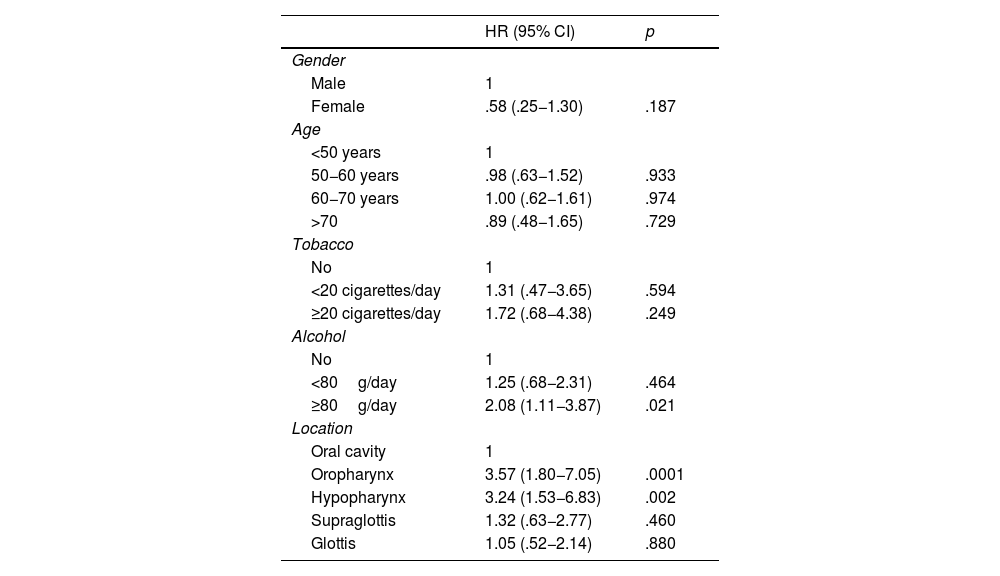Patients with head and neck squamous cell carcinoma (HNSCC) have an increased risk of second esophageal neoplasms. The aim of the present study is to evaluate the incidence, risk factors and prognosis of second esophageal neoplasms in patients with HNSCC.
MethodsA retrospective study of 4711 patients with index tumor in the oral cavity, oropharynx, hypopharynx or larynx between 1985 and 2020 was conducted.
ResultsDuring the period analysed 149 patients (3.2%) had a second esophageal neoplasm. The incidence of second esophageal neoplasia was 0.42% per year and remained nearly constant throughout the follow-up period. According to the results of a multivariate study, the risk factors related to the appearance of second esophageal neoplasms were a history of high alcohol consumption and the location of the primary tumor in the oropharynx or hypopharynx. The 5-year disease-specific survival rate in patients with a second esophageal neoplasm, calculated from the diagnosis of this second neoplasm, was 10.5%.
ConclusionsPatients with a HNSCC have an increased risk of developing of a second esophageal neoplasm. The risk factors associated with the appearance of a second esophageal neoplasm were severe alcohol consumption and the location of the primary tumor in the oropharynx or hypopharynx.
Los pacientes con un carcinoma escamoso de cabeza y cuello (CECC) tienen un riesgo incrementado de aparición de segundas neoplasias esofágicas. El objetivo del presente estudio es evaluar la incidencia de aparición, los factores de riesgo y el pronóstico de las segundas neoplasias esofágicas en los pacientes con un CECC.
Material y métodosRealizamos un estudio retrospectivo en 4.711 pacientes con un tumor índice localizado en la cavidad oral, orofaringe, hipofaringe o laringe durante el periodo 1985–2020.
ResultadosDurante el periodo analizado 149 pacientes (3,2%) presentaron una segunda neoplasia esofágica. La incidencia de segunda neoplasia esofágica fue del 0,42% anual y se mantuvo prácticamente constante a lo largo del periodo de seguimiento analizado. De acuerdo con el resultado del estudio multivariante, los factores de riesgo relacionados con la aparición de segundas neoplasias esofágicas fueron: el antecedente de un consumo elevado de alcohol y la localización del tumor primario en la orofaringe o la hipofaringe. La supervivencia específica a los 5 años para los pacientes con una segunda neoplasia de esófago, calculada a partir del diagnóstico de esta segunda neoplasia, fue del 10,5%.
ConclusionesLos pacientes con un CECC tienen un riesgo incrementado de sufrir la aparición de una segunda neoplasia esofágica. Los factores de riesgo asociados con la aparición de una segunda neoplasia esofágica fueron el consumo severo de alcohol y la localización del tumor primario en la orofaringe o la hipofaringe.










